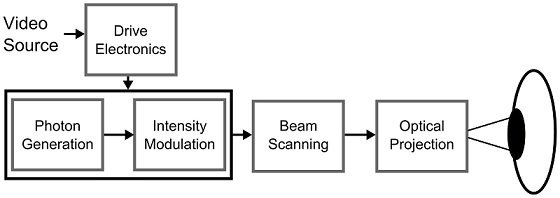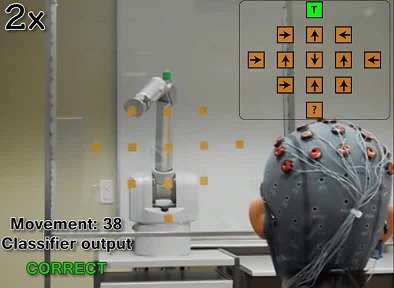Emerging technology on Screenless Video System
Have you ever imagined receiving visual information from a particular video source without using any of the traditional screen technology? Well, if you haven’t, then I welcome you to the future of emerging technologies; where everything is possible.

[Image Source: Wikimedia Commons]
Just like you may have already figured out “screenless video system” is the process of propagating visual data without using the screen. There are many ways to achieve this, but for the purpose of this survey, we shall be considering just four screenless display technology.
1. Retinal Display
Just like the name suggests, the video/image data from the source is projected directly into the retina without passing through any intervening medium.
A special device called “retinal projector” is used to achieve this, where the user of this technology will visualize the data as images floating in space, but which only him can see.

[Image Source: Wikimedia Commons]
The advantage of this over some other forms of screenless tech is the level of privacy it offers. You can view and work on a classified data even in public, without the fear of getting the data identity compromised by a third party. This is because the display would be directed to the specific pupils that the data are meant for.
2. Brain-Computer Display (Synaptic interface)
In the retinal display above, the display makes use of light which is directed to the pupils. But in the case of Synaptic interface, “light” is completely bypassed.

[Image Source: Wikimedia Commons]
The information generated by the computational device is directly relayed to the brain. This is an advanced form of BCI (Brain-Computer Interface). In other words, the biological eyes are completely sidelined.
The potentials in this technology are immense. For example, in the case of blind people, the visual file generated can be sent directly to the brain without relying on the eyes as the intervening medium (just like watching movie directly with your brain). This will no doubt aid them to get a better “view” of the environment around them, and the world at large.
The first step in achieving this is by linking the user’s brain to the computational device using a wearable electroencephalogram (EEG) headset. The headset will perceive the information generated by the computer and convert it into electrical signals which are sent to the brain for interpretation.
Advances are also being made for a brain chip that would have the same functionality as the EEG headset, so as to ease up the need to wear a “grumpy” headset around.
3. Holographic Display
This is the most popular and commonly used screenless display system, where visual files are propagated in a “3-D diffused ambient light”. This display is called “Hologram”
Realism has also been added to holographic display that one could easily mistake them for a real scenario.
Let’s look at how holographic display works from this video I got from the YouTube account of Chauncey Frend
4. Fog Display
This is not too popular, but I felt there’s a need to touch it in bit. In fog display, the video/image file generated from the computational device is sent to a special haze machine which produces an outburst of haze or fog that looks translucent, which then propagates the images in the fog.

[Image Source: Wikimedia Commons]
This is just like watching a movie in the clouds. This technology can also be called vapour display.
The advantage of this is that it is easy to set up, as the haze machine is portable and can be carried about. Also, the effect it adds to a movie theatre, for example, is remarkable, because of the realism it adds to movies.
This however, has a downturn. It is only suitable to be used indoors (in a confined space), and it is almost impracticable to be used outdoors. This is because, the atmospheric conditions (sun, wind, temperature, etc) would affect the propagation of the fog.
Advantages of screenless display devices
In privacy: we live in an era where privacy matter, and this can be compromised at any instance, even through the viewing and propagation of classified files. But some of these screenless display techs, like BCI and retinal display offer that level of privacy. Thanks to technology.
High resolution 3-D image/video quality: the traditional screen is limited in capacity, in the sense that it provides 2-D display of video files. But techs like the hologram and the fog display can provide a 3-D imagery of the file, thus increasing our interaction with the file.
Disadvantages of screenless devices
There are some downturns in this technology and I will like to list some:
High cost: in comparison to the traditional screen display, these screenless technologies are not too cost effective. Most of our homes have LCD/LED screens, but how many of us have the hologram projector, for example. The reason behind this could be the high cost of procuring one.
Health challenges: The interaction between light source directly with the retina (in the case of retinal display) can pose serious health issues in the long run. Also in the case of BCI, the tech could go awry and start producing fragments of unrelated images in the user’s brain.
But in all these disadvantages; in my opinion, the advantages far outweigh the downturns. Technology keeps getting better.
Thanks for reading
Images are CCO licensed
References for further reading: Ref1, Ref2, Ref3, Ref4, Ref5, Ref6


gif by @foundation
Being A SteemStem Member
Thanks a lot
Heard a lot... Nice post... Looks it would be our future sammy
Lol. Thanks a lot
Thanks for sharing this brilliant post my good @samminator
Thanks for reading :)
Nice post. Though this technology might seem very expensive now, further innovation will make it smaller and cheaper
Lol. Maybe, but technology would keep advancing :)
sorry for the earlier typo
Wow!
Looks interesting!
I still don‘t thinkt it will be adopted in the near future...maybe in like 10 years or something! Technology needs to mature :)
Thanks a lot for dropping by
V nice
thanks
Being A SteemStem Member
Thank God I completed it before rushing to ask if the retina display wouldn't be dangerous to the eyes, but you mentioned it already later.
These technologies are really interesting. They are on the high side tho, maybe they would best or mostly be implemented in high tech world...
Thanks for informing us